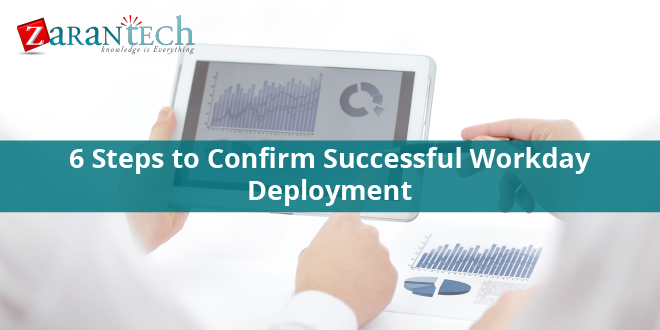6 Steps to Confirm Successful Workday Deployment
Category: Workday HCM Posted:Jul 06, 2018 By: Serena Josh
Presently, Workday HCM is one of the leading software used by many organizations. It has become the topmost choice of maximum organizations. Due to its numerous features, enterprises are attracted to Workday’s software. It is a cloud-based solution that provides a single solution for all the HR related activities like financial management, human capital management, performance management, etc. It is designed for almost all the size of the businesses, especially companies with multiple locations. With the help of Workday’s real reporting and analytic feature, the organization’s people can take quicker and better business decisions.
Every organization has its own standards. Therefore, there is an ecosystem of expert consultants and consulting partners who utilize a common procedure to deploy Workday applications. Workday’s lively partner ecosystem helps to confirm the successful deployment. Around 75 % of Workday deployments are controlled by expert consulting partners, that range from small to large firms and from global systems integrators to HR business-process outsourcing providers. With the help of this multiplicity, the customers can find out the appropriate set of skills to achieve any deployment need. A process is followed by the Workday to certify all the partner consultants and grasp quarterly business reviews with every partner to monitor customer satisfaction and to track projects.
There is a standard Workday accelerated deployment method that ensures a reliable deployment approach and easy and simple communication within the ecosystem. According to their service offerings, partners can utilize the method to meet the specific customer’s requirement in a better way. There are around 270 and more preconfigured business procedures provided by the Workday, which is used as a starting point for a distinct deployment and iterative prototyping allows the customers to twist these procedures so that the specific needs can be achieved.

There are various education opportunities provided by Workday, which offers the correct training to the correct people via the right delivery vehicle.
First is classroom training which emphasis on helping essential project teams and administrator to get an understanding of configuration and utilization of Workday.
Next is Virtual classroom training which helps the technical teams, power users, and administrators to set up and maintain the security, define business processes and the use of Workday reporting and integration tools.
Apart from these trainings, the on-demand education offers the necessary knowledge to the current users, and new peoples those who are running the daily Workday processes to be successful in their job responsibilities. The number of technical and functional topics are covered by these offerings.
The adoption toolkits of a Workday support a fast and easy on-ramp of employee and manager users, which includes an enabler guide, how to steps, FAQs, and visual demos.
Workday provides a framework for success series, which is involved as a part of the Workday subscription that is delivered through the Customer channel, i.e. the one shop on the Workday community site for deployment tools and resources. It basically consists of a series of online presentation which helps the customer at the time of production to understand the roles and support the organizations in the framing structure. There are few Workday updates that are available in the Workday community.
Tools to keep you connected: These tools plan the free resources and educational opportunities that are available via the Workday community.
Preparing for Life in Production: This helps you to understand the key roles required and provide suggestions on how you can structure your support organizations.
With the help of the framework, you can know what resources are available after the post-deployment to identify and obtain extra value from the Workday investment. The Workday updates take you towards what happens and what needs to be done when Workday updates its suite of applications. On the other hand, customer readiness offers important information, which makes you ready to manage the Workday in your organization.
Workday provides delivery assurance which is another premium service provided to the customers in which various product experts and consultants from the ecosystem measures the configurations and integrations at the different phases of deployment. With the help of this service, you can identify the best practices and obtain the best results from the deployment. The various services are:
1.Project Plan Review: In order to identify the critical responsibilities and milestones and to confirm that the project plan is according to the Workday Accelerated Deployment technique project plan review offers a review regarding the project plan.
2.Integration Design Review: This review offers an evaluation of the initial integration design at the early stage of the project and checks arranging with the best practices in mind.
3.Prototype Configuration Review: It provides an assessment regarding the early design and configuration. This review is implemented before the system testing in order to recognize any initial issues.
4.Integration Build Review: This review permits the system configuration assessment and a detailed code.
5.Final Configuration Review: This review provides a final assessment of the design and configuration that can proceed to the production.
Well, there are some points that should be kept in mind at the time of the deployment phase:
1.Communication: A communication plan should be a part of honest planning. The communication can be done in such a way that it should go beyond the timeline for sending out the emails and advertising on walls and should be more strategic in nature. You should think about the internal customers and also the peoples to whom you are going to communicate. It is required to balance the leadership positions with the information that needs to be shared and also their interest. For example, the peoples who are in a higher position and have some interest in day-to-day operations are the important community. The people who are high in interest, but are low in leadership positions should be satisfied. Some peoples should be managed closely that is those who are high in leadership as well as in interest. The people should be monitored simply who have less power and interest.
2.Data Conversion: when the project has to be launched, you should know the information and then start putting the data strategy together. You should think about the state of the data, whether it can be any data strategy like legacy systems, payroll systems, offline access databases, Excel, etc.
3.Timing: It is required to know about the ongoing activities and other business events such as audits. Financial business services are a good example of this. It is required to accommodate the times into the project plan as the project team is going to pull out from the Workday deployment.
4.Scope and Needs of Business: When you scope out the project and create your roadmap, you should be definite that you are cooperating with the executives and the stakeholders to know the important thing from them and the decisions that are driving around the timing and functionality. You should get appreciation from the deployment partners for the different types of people you need to bring.
5.Process Re-engineering: In a few cases, the Workday deployment needs an extensive change in how things can be performed. It means to streamline the operations sometimes, and other times it means regulating them. If the process stakeholders don’t involve neither of these operations would take place. That time new Workday solution would be beneficial which will give you the directions and perform so in a narrow way.
6.Big Bang Vs Phase approach: During workday deployment, the meaning of the big bang would be different, especially if you are looking for it from the perspective of the full platform. It is defined as a deployment where all the features are moved almost at a similar time, whereas in phase it means overtime. The functionality should be chosen to roll out before you commit to one or the other and the people should be chosen to influence as the roadmaps are created. The people have to decide whether you have to go for the big bang or with the phase deployment.
Conclusion:
The deployment process helps to improve your time to value. Also, the high-quality deployment provides a good match for your requirements. After you go live, it understands and improves the investment value. The Workday ecosystem offers a broad and varied set of skills to achieve your deployment needs.





 99999999 (Toll Free)
99999999 (Toll Free)  +91 9999999
+91 9999999